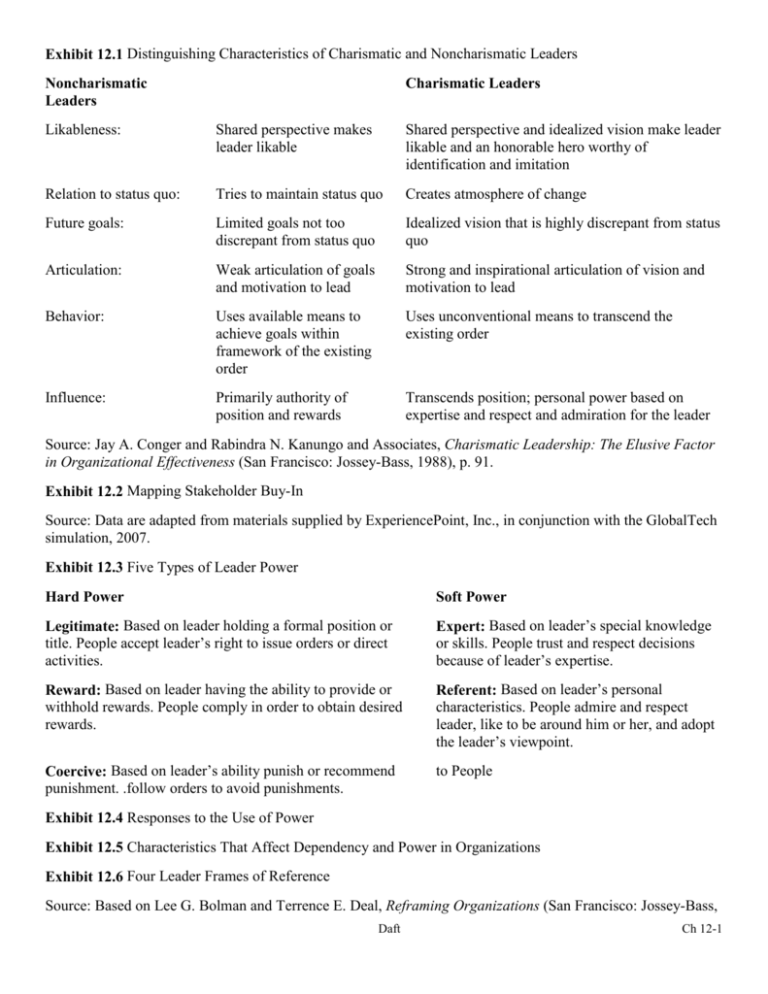Chapter 12: Leadership Power and Influence
advertisement

Exhibit 12.1 Distinguishing Characteristics of Charismatic and Noncharismatic Leaders Noncharismatic Leaders Charismatic Leaders Likableness: Shared perspective makes leader likable Shared perspective and idealized vision make leader likable and an honorable hero worthy of identification and imitation Relation to status quo: Tries to maintain status quo Creates atmosphere of change Future goals: Limited goals not too discrepant from status quo Idealized vision that is highly discrepant from status quo Articulation: Weak articulation of goals and motivation to lead Strong and inspirational articulation of vision and motivation to lead Behavior: Uses available means to achieve goals within framework of the existing order Uses unconventional means to transcend the existing order Influence: Primarily authority of position and rewards Transcends position; personal power based on expertise and respect and admiration for the leader Source: Jay A. Conger and Rabindra N. Kanungo and Associates, Charismatic Leadership: The Elusive Factor in Organizational Effectiveness (San Francisco: Jossey-Bass, 1988), p. 91. Exhibit 12.2 Mapping Stakeholder Buy-In Source: Data are adapted from materials supplied by ExperiencePoint, Inc., in conjunction with the GlobalTech simulation, 2007. Exhibit 12.3 Five Types of Leader Power Hard Power Soft Power Legitimate: Based on leader holding a formal position or title. People accept leader’s right to issue orders or direct activities. Expert: Based on leader’s special knowledge or skills. People trust and respect decisions because of leader’s expertise. Reward: Based on leader having the ability to provide or withhold rewards. People comply in order to obtain desired rewards. Referent: Based on leader’s personal characteristics. People admire and respect leader, like to be around him or her, and adopt the leader’s viewpoint. Coercive: Based on leader’s ability punish or recommend punishment. .follow orders to avoid punishments. to People Exhibit 12.4 Responses to the Use of Power Exhibit 12.5 Characteristics That Affect Dependency and Power in Organizations Exhibit 12.6 Four Leader Frames of Reference Source: Based on Lee G. Bolman and Terrence E. Deal, Reframing Organizations (San Francisco: Jossey-Bass, Daft Ch 12-1 1991); and L. G. Bolman and T. E. Deal, “Leadership and Management Effectiveness: A Multi-Frame, MultiSector Analysis,” Human Resource Management 30, no. 4 (Winter 1991), pp. 509–534. Thanks to Roy Williams for suggesting the stair sequence. Exhibit 12.7 Seven Principles for Asserting Leader Influence 1. Use rational persuasion. 2. Make people like you. 3. Rely on the rule of reciprocity. 4. Develop allies. 5. Ask for what you want. 6. Remember the principle of scarcity. 7. Extend formal authority with expertise and credibility. Exhibit 12.8 Guidelines for Ethical Action Sources: Based on G. F. Cavanaugh, D. J. Mobert, and M. Valasques, “The Ethics of Organizational Politics,” Academy of Management Journal, (June 1981), pp. 363–374; and Stephen P. Robbins, Organizational Behavior, 8th ed. (Upper Saddle River, NJ: Prentice Hall, 1998), p. 422. Ch 12-2 Daft











